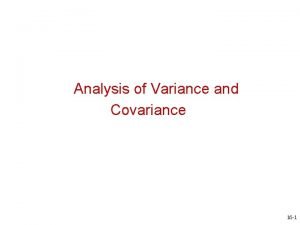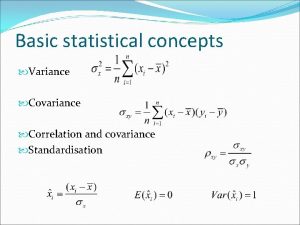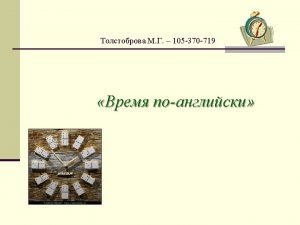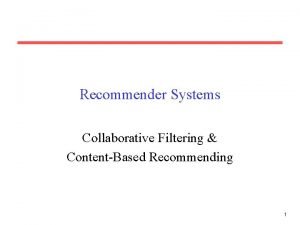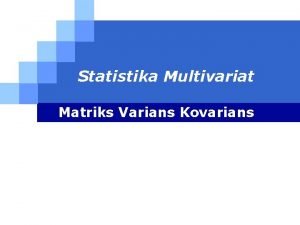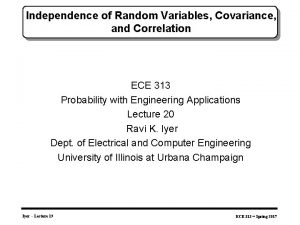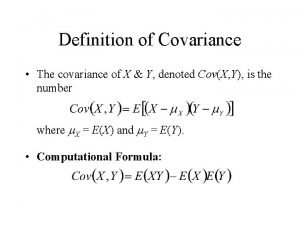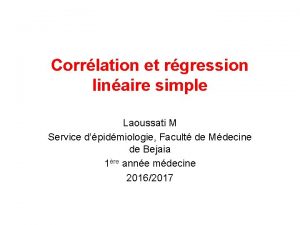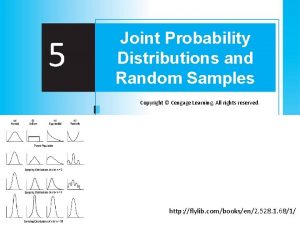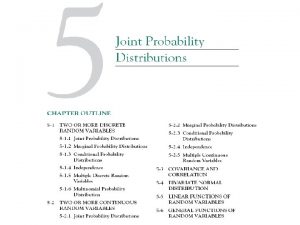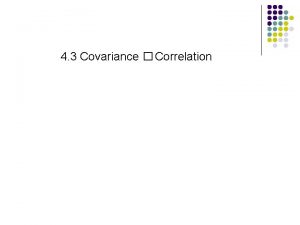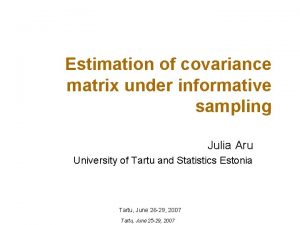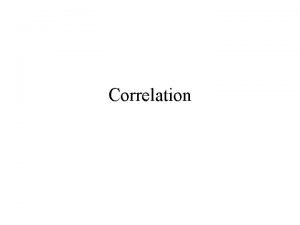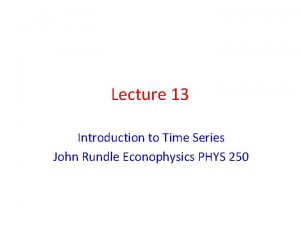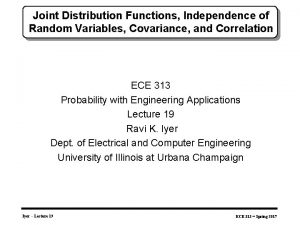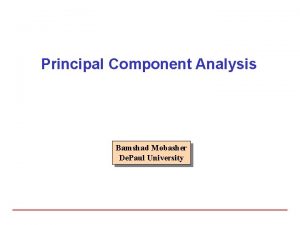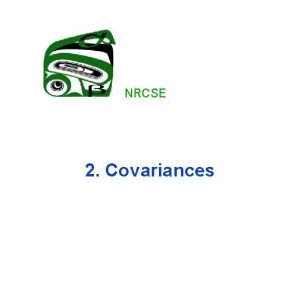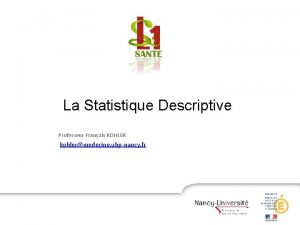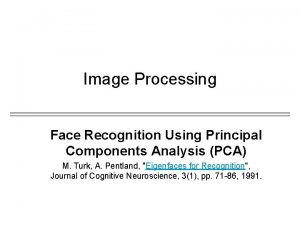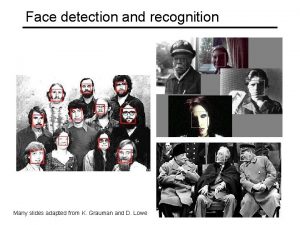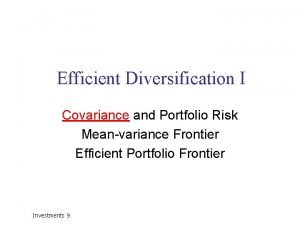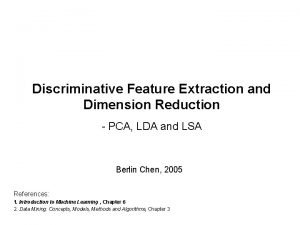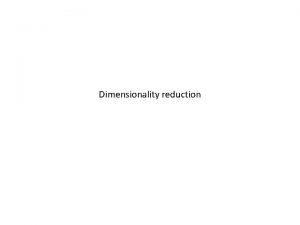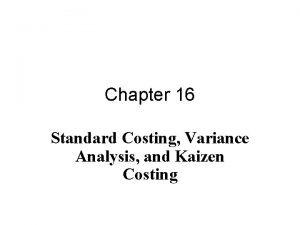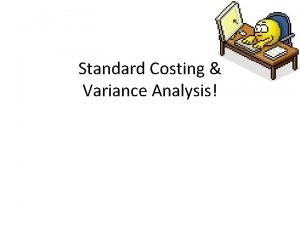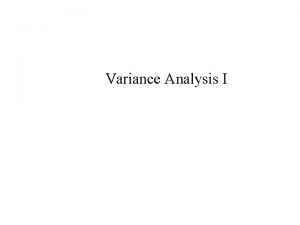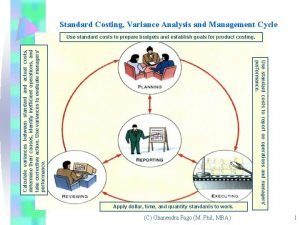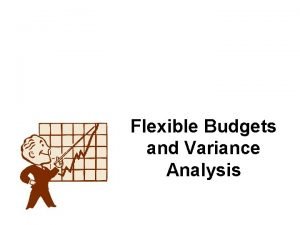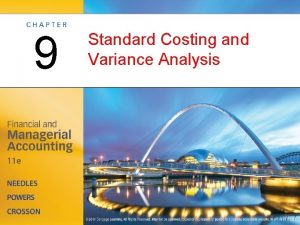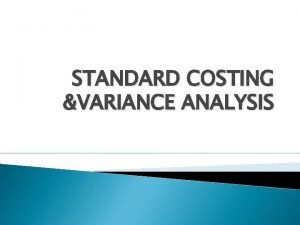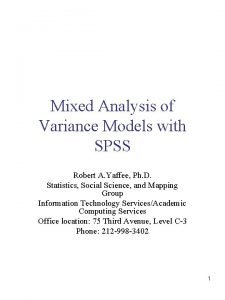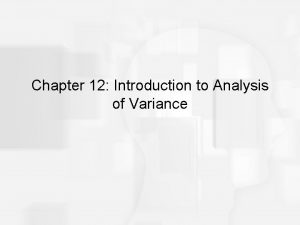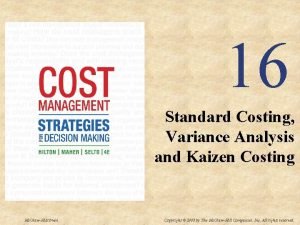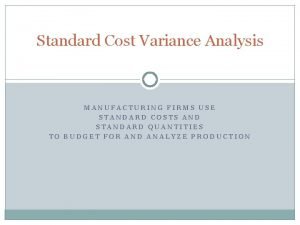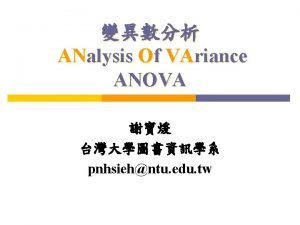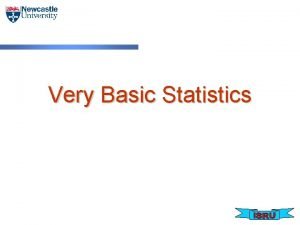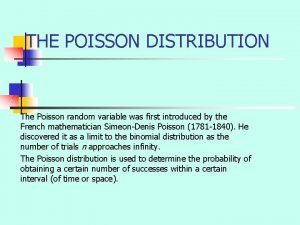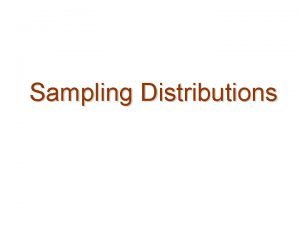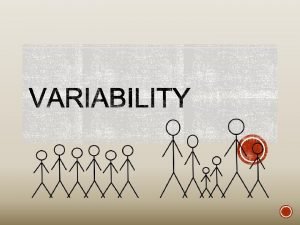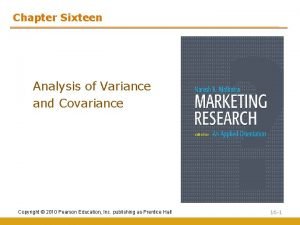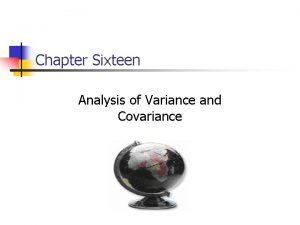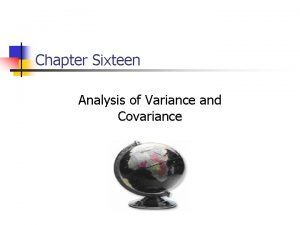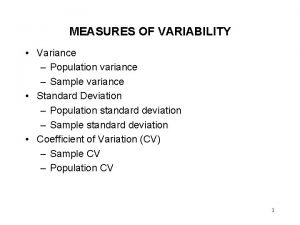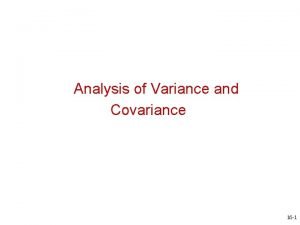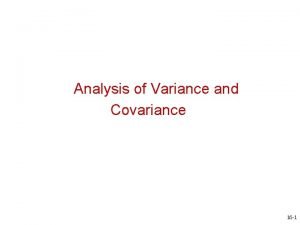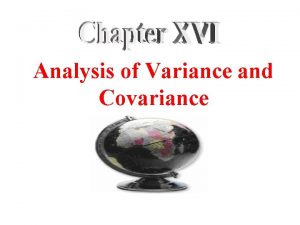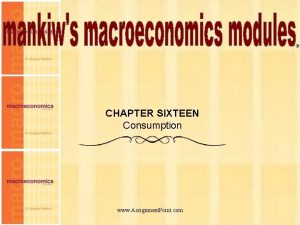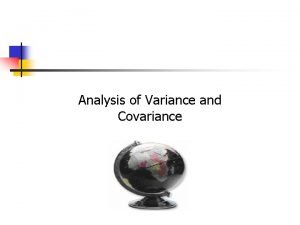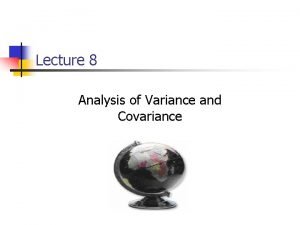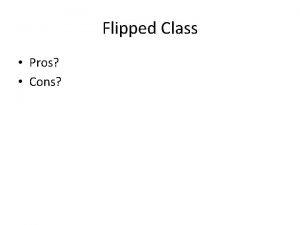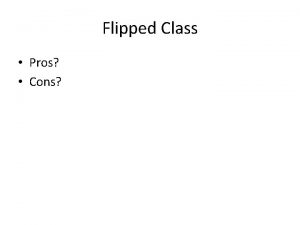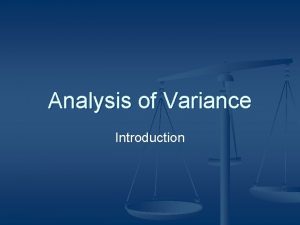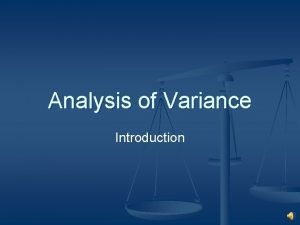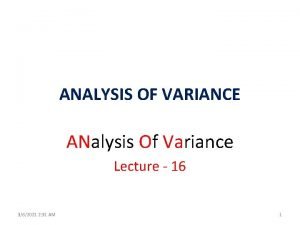Chapter Sixteen Analysis of Variance and Covariance 16



















































- Slides: 51

Chapter Sixteen Analysis of Variance and Covariance

16 -2 Chapter Outline 1) Overview 2) Relationship Among Techniques 2) One-Way Analysis of Variance 3) Statistics Associated with One-Way Analysis of Variance 4) Conducting One-Way Analysis of Variance i. Identification of Dependent & Independent Variables ii. Decomposition of the Total Variation iii. Measurement of Effects iv. Significance Testing v. Interpretation of Results

16 -3 Chapter Outline 5) Illustrative Data 6) Illustrative Applications of One-Way Analysis of Variance 7) Assumptions in Analysis of Variance 8) N-Way Analysis of Variance 9) Analysis of Covariance 10) Issues in Interpretation i. Interactions ii. Relative Importance of Factors iii. Multiple Comparisons 11) Repeated Measures ANOVA

16 -4 Chapter Outline 12) Nonmetric Analysis of Variance 13) Multivariate Analysis of Variance 14) Internet and Computer Applications 15) Focus on Burke 16) Summary 17) Key Terms and Concepts

16 -5 Relationship Among Techniques n n n Analysis of variance (ANOVA) is used as a test of means for two or more populations. The null hypothesis, typically, is that all means are equal. Analysis of variance must have a dependent variable that is metric (measured using an interval or ratio scale). There must also be one or more independent variables that are all categorical (nonmetric). Categorical independent variables are also called factors.

16 -6 Relationship Among Techniques n n A particular combination of factor levels, or categories, is called a treatment. One-way analysis of variance involves only one categorical variable, or a single factor. In one-way analysis of variance, a treatment is the same as a factor level. If two or more factors are involved, the analysis is termed n-way analysis of variance. If the set of independent variables consists of both categorical and metric variables, the technique is called analysis of covariance (ANCOVA). In this case, the categorical independent variables are still referred to as factors, whereas the metricindependent variables are referred to as covariates.

Relationship Amongst Test, Analysis of Variance, Analysis of Covariance, & Regression 16 -7 Fig. 16. 1 Metric Dependent Variable One Independent Variable One or More Independent Variables Binary Categorical: Factorial Categorical and Interval t Test Analysis of Variance Analysis of Covariance Regression One Factor More than One Factor One-Way Analysis of Variance N-Way Analysis of Variance

16 -8 One-way Analysis of Variance Marketing researchers are often interested in examining the differences in the mean values of the dependent variable for several categories of a single independent variable or factor. For example: n n n Do the various segments differ in terms of their volume of product consumption? Do the brand evaluations of groups exposed to different commercials vary? What is the effect of consumers' familiarity with the store (measured as high, medium, and low) on preference for the store?

Statistics Associated with One-way Analysis of Variance n n 16 -9 eta 2 ( 2). The strength of the effects of X (independent variable or factor) on Y (dependent variable) is measured by eta 2 ( 2). The value of 2 varies between 0 and 1. F statistic. The null hypothesis that the category means are equal in the population is tested by an F statistic based on the ratio of mean square related to X and mean square related to error. n Mean square. This is the sum of squares divided by the appropriate degrees of freedom.

Statistics Associated with One-way Analysis of Variance n n n 16 -10 SSbetween. Also denoted as SSx, this is the variation in Y related to the variation in the means of the categories of X. This represents variation between the categories of X, or the portion of the sum of squares in Y related to X. SSwithin. Also referred to as SSerror, this is the variation in Y due to the variation within each of the categories of X. This variation is not accounted for by X. SSy. This is the total variation in Y.

16 -11 Conducting One-way ANOVA Fig. 16. 2 Identify the Dependent and Independent Variables Decompose the Total Variation Measure the Effects Test the Significance Interpret the Results

Conducting One-way Analysis of Variance 16 -12 Decompose the Total Variation The total variation in Y, denoted by SSy, can be decomposed into two components: SSy = SSbetween + SSwithin where the subscripts between and within refer to the categories of X. SSbetween is the variation in Y related to the variation in the means of the categories of X. For this reason, SSbetween is also denoted as SSx. SSwithin is the variation in Y related to the variation within each category of X. SSwithin is not accounted for by X. Therefore it is referred to as SSerror.

Conducting One-way Analysis of Variance Decompose the Total Variation The total variation in Y may be decomposed as: SSy = SSx + SSerror where N SS y =S (Y i -Y 2 ) i =1 c SS x =S n (Y j -Y )2 j =1 c SS error=S n S (Y ij -Y j )2 j i Yi = individual observation j = mean for category j = mean over the whole sample, or grand mean Yij = i th observation in the j th category 16 -13

Decomposition of the Total Variation: One-way ANOVA 16 -14 Table 16. 1 Independent Variable Within Category Variation =SSwithin Category Mean X 1 Y 2 : : Yn Y 1 X Total Sample X 2 Y 1 Y 2 Categories X 3 … Y 1 Y 2 Xc Y 1 Y 2 Yn Y 3 Yn Yc Y 1 Y 2 : : YN Y Between Category Variation = SSbetween Total Variation =SSy

16 -15 Conducting One-way Analysis of Variance In analysis of variance, we estimate two measures of variation: within groups (SSwithin) and between groups (SSbetween). Thus, by comparing the Y variance estimates based on between-group and within-group variation, we can test the null hypothesis. Measure the Effects The strength of the effects of X on Y are measured as follows: 2 = SSx/SSy = (SSy - SSerror)/SSy The value of 2 varies between 0 and 1.

Conducting One-way Analysis of Variance 16 -16 Test Significance In one-way analysis of variance, the interest lies in testing the null hypothesis that the category means are equal in the population. H 0: µ 1 = µ 2 = µ 3 =. . . = µc Under the null hypothesis, SSx and SSerror come from the same source of variation. In other words, the estimate of the population variance of Y, or = SSx/(c - 1) = Mean square due to X = MSx = SSerror/(N - c) = Mean square due to error = MSerror

Conducting One-way Analysis of Variance 16 -17 Test Significance The null hypothesis may be tested by the F statistic based on the ratio between these two estimates: This statistic follows the F distribution, with (c - 1) and (N - c) degrees of freedom (df).

Conducting One-way Analysis of Variance 16 -18 Interpret the Results n n n If the null hypothesis of equal category means is not rejected, then the independent variable does not have a significant effect on the dependent variable. On the other hand, if the null hypothesis is rejected, then the effect of the independent variable is significant. A comparison of the category mean values will indicate the nature of the effect of the independent variable.

Illustrative Applications of One-way Analysis of Variance 16 -19 We illustrate the concepts discussed in this chapter using the data presented in Table 16. 2. The department store is attempting to determine the effect of in-store promotion (X) on sales (Y). For the purpose of illustrating hand calculations, the data of Table 16. 2 are transformed in Table 16. 3 to show the store sales (Yij) for each level of promotion. The null hypothesis is that the category means are equal: H 0: µ 1 = µ 2 = µ 3.

16 -20 Effect of Promotion and Clientele on Sales Table 16. 2

Illustrative Applications of One-way Analysis of Variance 16 -21 TABLE 16. 3 EFFECT OF IN-STORE PROMOTION ON SALES Store Level of In-store Promotion No. High Medium Low Normalized Sales _________ 1 10 8 5 2 9 8 7 3 10 7 6 4 8 9 4 5 9 6 5 6 8 4 2 7 9 5 3 8 7 5 2 9 7 6 1 10 6 4 2 ___________________________ Column Totals 83 62 37 Category means: j 83/10 62/10 37/10 = 8. 3 = 6. 2 = 3. 7 Grand mean, = (83 + 62 + 37)/30 = 6. 067

Illustrative Applications of One-way Analysis of Variance To test the null hypothesis, the various sums of squares are computed as follows: SSy = (10 -6. 067)2 + (9 -6. 067)2 + (10 -6. 067)2 + (8 -6. 067)2 + (9 -6. 067)2 + (7 -6. 067)2 + (6 -6. 067)2 + (8 -6. 067)2 + (7 -6. 067)2 + (9 -6. 067)2 + (6 -6. 067)2 (4 -6. 067)2 + (5 -6. 067)2 + (6 -6. 067)2 + (4 -6. 067)2 + (5 -6. 067)2 + (7 -6. 067)2 + (6 -6. 067)2 + (4 -6. 067)2 + (5 -6. 067)2 + (2 -6. 067)2 + (3 -6. 067)2 + (2 -6. 067)2 + (1 -6. 067)2 + (2 -6. 067)2 =(3. 933)2 + (2. 933)2 + (3. 933)2 + (1. 933)2 + (2. 933)2 + (0. 933)2 + (-0. 067)2 + (1. 933)2 + (0. 933)2 + (2. 933)2 + (-0. 067)2 (-2. 067)2 + (-1. 067)2 + (-0. 067)2 + (-2. 067)2 + (-1. 067)2 + (0. 9333)2 + (-0. 067)2 + (-2. 067)2 + (-1. 067)2 + (-4. 067)2 + (-3. 067)2 + (-4. 067)2 + (-5. 067)2 + (-4. 067)2 = 185. 867 16 -22

Illustrative Applications of One-way Analysis of Variance (cont. ) SSx = 10(8. 3 -6. 067)2 + 10(6. 2 -6. 067)2 + 10(3. 7 -6. 067)2 = 10(2. 233)2 + 10(0. 133)2 + 10(-2. 367)2 = 106. 067 SSerror = (10 -8. 3)2 + (9 -8. 3)2 + (10 -8. 3)2 + (8 -8. 3)2 + (9 -8. 3)2 + (7 -8. 3)2 + (6 -8. 3)2 + (8 -6. 2)2 + (7 -6. 2)2 + (9 -6. 2)2 + (6 -6. 2)2 + (4 -6. 2)2 + (5 -6. 2)2 + (6 -6. 2)2 + (4 -6. 2)2 + (5 -3. 7)2 + (7 -3. 7)2 + (6 -3. 7)2 + (4 -3. 7)2 + (5 -3. 7)2 + (2 -3. 7)2 + (3 -3. 7)2 + (2 -3. 7)2 + (1 -3. 7)2 + (2 -3. 7)2 = (1. 7)2 + (0. 7)2 + (1. 7)2 + (-0. 3)2 + (0. 7)2 + (-1. 3)2 + (-2. 3)2 + (1. 8)2 + (0. 8)2 + (2. 8)2 + (-0. 2)2 + (-2. 2)2 + (-1. 2)2 + (-0. 2)2 + (-2. 2)2 + (1. 3)2 + (3. 3)2 + (2. 3)2 + (0. 3)2 + (1. 3)2 + (-1. 7)2 + (-0. 7)2 + (-1. 7)2 + (-2. 7)2 + (-1. 7)2 = 79. 80 16 -23

Illustrative Applications of One-way Analysis of Variance 16 -24 It can be verified that SSy = SSx + SSerror as follows: 185. 867 = 106. 067 +79. 80 The strength of the effects of X on Y are measured as follows: 2 = SSx/SSy = 106. 067/185. 867 = 0. 571 In other words, 57. 1% of the variation in sales (Y) is accounted for by in-store promotion (X), indicating a modest effect. The null hypothesis may now be tested. = 17. 944

Illustrative Applications of One-way Analysis of Variance n n 16 -25 From Table 5 in the Statistical Appendix we see that for 2 and 27 degrees of freedom, the critical value of F is 3. 35 for . Because the calculated value of F is greater than the critical value, we reject the null hypothesis. We now illustrate the analysis of variance procedure using a computer program. The results of conducting the same analysis by computer are presented in Table 16. 4.

One-Way ANOVA: Effect of In-store Promotion on Store Sales 16 -26 Table 16. 3 Source of Variation Between groups (Promotion) Within groups (Error) TOTAL Sum of squares 106. 067 df 2 Mean square 53. 033 79. 800 27 2. 956 185. 867 29 6. 409 Cell means Level of Promotion High (1) Medium (2) Low (3) Count Mean 10 10 10 8. 300 6. 200 3. 700 TOTAL 30 6. 067 F ratio F prob. 17. 944 0. 000

16 -27 Assumptions in Analysis of Variance 1. The salient assumptions in analysis of variance can be summarized as follows. Ordinarily, the categories of the independent variable are assumed to be fixed. Inferences are made only to the specific categories considered. This is referred to as the fixed-effects model. 2. The error term is normally distributed, with a zero mean and a constant variance. The error is not related to any of the categories of X. 3. The error terms are uncorrelated. If the error terms are correlated (i. e. , the observations are not independent), the F ratio can be seriously distorted.

16 -28 N-way Analysis of Variance In marketing research, one is often concerned with the effect of more than one factor simultaneously. For example: n n n How do advertising levels (high, medium, and low) interact with price levels (high, medium, and low) to influence a brand's sale? Do educational levels (less than high school, high school graduate, some college, and college graduate) and age (less than 35, 35 -55, more than 55) affect consumption of a brand? What is the effect of consumers' familiarity with a department store (high, medium, and low) and store image (positive, neutral, and negative) on preference for the store?

16 -29 N-way Analysis of Variance Consider the simple case of two factors X 1 and X 2 having categories c 1 and c 2. The total variation in this case is partitioned as follows: SStotal = SS due to X 1 + SS due to X 2 + SS due to interaction of X 1 and X 2 + SSwithin or The strength of the joint effect of two factors, called the overall effect, or multiple 2, is measured as follows: multiple 2 =

16 -30 N-way Analysis of Variance The significance of the overall effect may be tested by an F test, as follows where dfn = = = dfd = = MS = degrees of freedom for the numerator (c 1 - 1) + (c 2 - 1) + (c 1 - 1) (c 2 - 1) c 1 c 2 - 1 degrees of freedom for the denominator N - c 1 c 2 mean square

16 -31 N-way Analysis of Variance If the overall effect is significant, the next step is to examine the significance of the interaction effect. Under the null hypothesis of no interaction, the appropriate F test is: where dfn = (c 1 - 1) (c 2 - 1) dfd = N - c 1 c 2

16 -32 N-way Analysis of Variance The significance of the main effect of each factor may be tested as follows for X 1: where dfn = c 1 - 1 dfd = N - c 1 c 2

16 -33 Two-way Analysis of Variance Table 16. 4 Source of Variation Main Effects Promotion Coupon Combined Two-way interaction Model Residual (error) TOTAL Sum of squares df Mean square F Sig. of F 106. 067 53. 333 159. 400 3. 267 2 1 3 2 53. 033 53. 333 53. 133 1. 633 54. 862 55. 172 54. 966 1. 690 0. 000 0. 226 162. 667 5 23. 200 24 185. 867 29 32. 533 0. 967 6. 409 33. 655 0. 000 2 0. 557 0. 280

16 -34 Two-way Analysis of Variance Table 16. 4 cont. Cell Means Promotion High Medium Low TOTAL Coupon Yes No Count 5 5 5 Mean 9. 200 7. 400 7. 600 4. 800 5. 400 2. 000 30 Factor Level Means Promotion High Medium Low Coupon Yes No Grand Mean Count 10 10 10 15 15 30 Mean 8. 300 6. 200 3. 700 7. 400 4. 733 6. 067

16 -35 Analysis of Covariance When examining the differences in the mean values of the dependent variable related to the effect of the controlled independent variables, it is often necessary to take into account the influence of uncontrolled independent variables. For example: n n n In determining how different groups exposed to different commercials evaluate a brand, it may be necessary to control for prior knowledge. In determining how different price levels will affect a household's cereal consumption, it may be essential to take household size into account. We again use the data of Table 16. 2 to illustrate analysis of covariance. Suppose that we wanted to determine the effect of in-store promotion and couponing on sales while controlling for the affect of clientele. The results are shown in Table 16. 6.

16 -36 Analysis of Covariance Table 16. 5 df Mean Square F Sig. of F 0. 838 1 0. 838 0. 862 0. 363 Promotion 106. 067 2 53. 033 54. 546 0. 000 Coupon 53. 333 1 53. 333 54. 855 0. 000 Combined 159. 400 3 53. 133 54. 649 0. 000 Promotion* Coupon 3. 267 2 1. 633 1. 680 0. 208 Model Residual (Error) TOTAL Covariate Clientele 163. 505 22. 362 185. 867 Raw Coefficient -0. 078 6 23 29 27. 251 0. 972 6. 409 28. 028 0. 000 Source of Variation Covariance Clientele Main effects Sum of Squares 2 -Way Interaction

16 -37 Issues in Interpretation Important issues involved in the interpretation of ANOVA results include interactions, relative importance of factors, and multiple comparisons. Interactions n The different interactions that can arise when conducting ANOVA on two or more factors are shown in Figure 16. 3. Relative Importance of Factors n Experimental designs are usually balanced, in that each cell contains the same number of respondents. This results in an orthogonal design in which the factors are uncorrelated. Hence, it is possible to determine unambiguously the relative importance of each factor in explaining the variation in the dependent variable.

16 -38 A Classification of Interaction Effects Figure 16. 3 Possible Interaction Effects No Interaction (Case 1) Interaction Ordinal (Case 2) Disordinal Noncrossover (Case 3) Crossover (Case 4)

16 -39 Patterns of Interaction Figure 16. 4 Case 1: No Interaction X 22 X Y 21 X 12 Case 2: Ordinal Interaction X 22 Y X X 13 Case 3: Disordinal Interaction: Noncrossover X 22 Y X 21 21 X X X 11 12 13 Case 4: Disordinal Interaction: Crossover X 22 Y X 21 X 12 X 13 X 11 X 12 X 13

16 -40 Issues in Interpretation n n The most commonly used measure in ANOVA is omega squared, . This measure indicates what proportion of the w 2 variation in the dependent variable is related to a particular independent variable or factor. The relative contribution of a factor X is calculated as follows: Normally, is interpreted only for statistically significant effects. w 2 In Table 16. 5, associated with the level of in-store promotion is calculated as follows: = 0. 557

16 -41 Issues in Interpretation Note, in Table 16. 5, that SStotal = 106. 067 + 53. 333 + 3. 267 + 23. 2 = 185. 867 w 2 Likewise, the associated with couponing is: = 0. 280 As a guide to interpreting , a large experimental effect produces an index of 0. 15 or greater, a medium effect produces an index of around 0. 06, and a small effect produces an index of 0. 01. In Table 16. 5, while the effect of promotion and couponing are both large, the effect of promotion is much larger.

Issues in Interpretation 16 -42 Multiple Comparisons n n If the null hypothesis of equal means is rejected, we can only conclude that not all of the group means are equal. We may wish to examine differences among specific means. This can be done by specifying appropriate contrasts, or comparisons used to determine which of the means are statistically different. A priori contrasts are determined before conducting the analysis, based on the researcher's theoretical framework. Generally, a priori contrasts are used in lieu of the ANOVA F test. The contrasts selected are orthogonal (they are independent in a statistical sense).

Issues in Interpretation 16 -43 Multiple Comparisons n A posteriori contrasts are made after the analysis. These are generally multiple comparison tests. They enable the researcher to construct generalized confidence intervals that can be used to make pairwise comparisons of all treatment means. These tests, listed in order of decreasing power, include least significant difference, Duncan's multiple range test, Student-Newman-Keuls, Tukey's alternate procedure, honestly significant difference, modified least significant difference, and Scheffe's test. Of these tests, least significant difference is the most powerful, Scheffe's the most conservative.

16 -44 Repeated Measures ANOVA One way of controlling the differences between subjects is by observing each subject under each experimental condition (see Table 16. 7). Since repeated measurements are obtained from each respondent, this design is referred to as withinsubjects design or repeated measures analysis of variance. Repeated measures analysis of variance may be thought of as an extension of the pairedsamples t test to the case of more than two related samples.

Decomposition of the Total Variation: Repeated Measures ANOVA 16 -45 Table 16. 6 Independent Variable Subject Categories No. Between People Variation =SSbetween people Total Sample X 1 X 2 X 3 1 Y 12 Y 13 Y 1 c Y 1 2 Y 21 : : Yn 1 Y 22 Y 23 Y 2 c Yn 2 Yn 3 Ync Y 2 : : YN Y 1 Y 2 Y 3 Yc Y n Category Mean X … Xc Within People Category Variation = SSwithin people Total Variation =SSy

16 -46 Repeated Measures ANOVA In the case of a single factor with repeated measures, the total variation, with nc - 1 degrees of freedom, may be split into between-people variation and within-people variation. SStotal = SSbetween people + SSwithin people The between-people variation, which is related to the differences between the means of people, has n - 1 degrees of freedom. The within-people variation has n (c - 1) degrees of freedom. The within-people variation may, in turn, be divided into two different sources of variation. One source is related to the differences between treatment means, and the second consists of residual or error variation. The degrees of freedom corresponding to the treatment variation are c - 1, and those corresponding to residual variation are (c - 1) (n -1).

16 -47 Repeated Measures ANOVA Thus, SSwithin people = SSx + SSerror A test of the null hypothesis of equal means may now be constructed in the usual way: So far we have assumed that the dependent variable is measured on an interval or ratio scale. If the dependent variable is nonmetric, however, a different procedure should be used.

16 -48 Nonmetric Analysis of Variance n n Nonmetric analysis of variance examines the difference in the central tendencies of more than two groups when the dependent variable is measured on an ordinal scale. One such procedure is the k-sample median test. As its name implies, this is an extension of the median test for two groups, which was considered in Chapter 15.

16 -49 Nonmetric Analysis of Variance n n A more powerful test is the Kruskal-Wallis one way analysis of variance. This is an extension of the Mann. Whitney test (Chapter 15). This test also examines the difference in medians. All cases from the k groups are ordered in a single ranking. If the k populations are the same, the groups should be similar in terms of ranks within each group. The rank sum is calculated for each group. From these, the Kruskal-Wallis H statistic, which has a chi-square distribution, is computed. The Kruskal-Wallis test is more powerful than the ksample median test as it uses the rank value of each case, not merely its location relative to the median. However, if there a large number of tied rankings in the data, the k-sample median test may be a better choice.

16 -50 Multivariate Analysis of Variance n n n Multivariate analysis of variance (MANOVA) is similar to analysis of variance (ANOVA), except that instead of one metric dependent variable, we have two or more. In MANOVA, the null hypothesis is that the vectors of means on multiple dependent variables are equal across groups. Multivariate analysis of variance is appropriate when there are two or more dependent variables that are correlated.

16 -51 SPSS Windows One-way ANOVA can be efficiently performed using the program COMPARE MEANS and then One-way ANOVA. To select this procedure using SPSS for Windows click: Analyze>Compare Means>One-Way ANOVA … N-way analysis of variance and analysis of covariance can be performed using GENERAL LINEAR MODEL. To select this procedure using SPSS for Windows click: Analyze>General Linear Model>Univariate …
 Multivariate analysis of variance and covariance
Multivariate analysis of variance and covariance Analysis of variance and covariance
Analysis of variance and covariance Variance correlation
Variance correlation Usage variance formula
Usage variance formula 16 point compass rose
16 point compass rose Whats a quarter past 8
Whats a quarter past 8 The sixteen career clusters
The sixteen career clusters Sixteen year old carrie is babysitting
Sixteen year old carrie is babysitting Sixteen securities inc
Sixteen securities inc Red mars
Red mars Kovarian matriks
Kovarian matriks Covariance between two random variables
Covariance between two random variables Définition de la covariance
Définition de la covariance Covariance formula
Covariance formula Formule covariance
Formule covariance Covariance properties
Covariance properties Covariance between two random variables
Covariance between two random variables Covariance definition
Covariance definition Julia covariance matrix
Julia covariance matrix Correlation covariance
Correlation covariance Corretion
Corretion Covariance of joint distribution
Covariance of joint distribution Covariance matrix
Covariance matrix Covariance
Covariance Définition de la covariance
Définition de la covariance Pcaچیست
Pcaچیست Covariance pca
Covariance pca Covariance in portfolio risk
Covariance in portfolio risk Covariance pca
Covariance pca Covariance pca
Covariance pca How to make a flexible budget
How to make a flexible budget Standard cost variance
Standard cost variance Flexible budgets and variance analysis
Flexible budgets and variance analysis Cima variance analysis
Cima variance analysis Static budget example
Static budget example The variance analysis cycle
The variance analysis cycle Tr
Tr Analysis of variance
Analysis of variance Variance analysis
Variance analysis Job cost variance
Job cost variance Mixed analysis of variance
Mixed analysis of variance Variance analysis in nursing
Variance analysis in nursing Introduction to analysis of variance
Introduction to analysis of variance Kaizen costing vs standard costing
Kaizen costing vs standard costing Dawson toys ltd
Dawson toys ltd Variance accounting meaning
Variance accounting meaning Mancova example
Mancova example Advantages and disadvantages of variance
Advantages and disadvantages of variance Variance and standard deviation formula
Variance and standard deviation formula Variance of poisson distribution
Variance of poisson distribution Real life example of sampling distribution
Real life example of sampling distribution What is a quantitative measure of variability
What is a quantitative measure of variability

